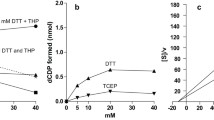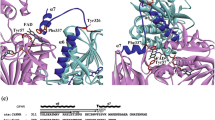Abstract
The activity of pure calf-liver and Escherichia coli thioredoxin reductases decreased drastically in the presence of NADPH or NADH, while NADP+, NAD+ and oxidized E. coli thioredoxin activated both enzymes significantly, particularly the bacterial one. The loss of activity under reducing conditions was time-dependent, thus suggesting an inactivation process: in the presence of 0.24 mM NADPH the half-lives for the E. coli and calf-liver enzymes were 13.5 and 2 min, respectively. Oxidized E. coli thioredoxin fully protected both enzymes from inactivation, and also promoted their complete reactivation after only 30 min incubation at 30° C. Lower but significant protection and reactivation was also observed with NADP+ and NAD+. EDTA protected thioredoxin reductase from NADPH inactivation to a great degree, thus indicating the participation of metals in the process; EGTA did not protect the enzyme from redox inactivation. Thioredoxin reductase was extensively inactivated by NADPH under aerobic and anaerobic conditions, thus excluding the participation of O2 or oxygen active species in redox inactivation. The loss of thioredoxin reductase activity promoted by NADPH was much faster and complete in the presence of NAD+ glycohydrolase, thus suggesting that inactivation was related to full reduction of the redox-active disulfide. Those results indicate that thioredoxin reductase activity can be modulated in bacteria and mammals by the redox status of NADP(H) and thioredoxin pools, in a similar way to glutathione reductase. This would considerably expand the regulatory potential of the thioredoxin-thioredoxin reductase system with the enzyme being self-regulated by its own substrate, a regulatory protein.
Similar content being viewed by others
Abbreviations
- DTNB:
-
5,5′-dithiobis(2-nitrobenzoate)
- EGTA:
-
Ethylenglycoltetraacetic Acid
- TNB:
-
5-thio-2-nitrobenzoate
- Trx:
-
Thioredoxin
- Trx(SH)2:
-
Reduced Thioredoxin
- Trx-S2:
-
Oxidized Thioredoxin
References
Holmgren A: Pyridine nucleotide-disulfide oxidoreductases. In: J Jeffrey (ed) Experientia supplementum: Dehydrogenases Requiring Nicotinamide Coenzymes. Birkhauser, Basel, 1980, pp 149–180
Brown NL, Ford SJ, Pridmore RD, Fritzinger DC: Nucleotide sequence of a gene from the Pseudomonas transposon Tn501 encoding mercuric reductase. Biochemistry 22: 4089–4095, 1983
Shames SL, Kimmel BE, Peoples OP, Agabian N, Walsh CT: Trypanothione reductase of Trypanosoma congolense. Gene isolation, primary sequence determination, and comparison to glutathione reductase. Biochemistry 27: 5014–5019, 1988
Karplus PA, Schutz GE: Refined structure of glutathione reductase at 1.54 Å resolution. J Mol Biol 195: 701–729, 1987
Russel M, Model P: Sequence of thioredoxin reductase from Escherichia coli. Relationship to other flavoprotein disulfide oxidoreductases. J Biol Chem 263: 9015–9019, 1988
Kuriyan J, Wong L, Russel M, Model P: Crystallization and preliminary X-ray characterization of thioredoxin reductase from Escherichia coli. J Biol Chem 264: 12752–12753, 1989
Kuriyan J: X ray structure of E. coli thioredoxin reductase at 2.7 Å. Communication to the Jacques Monod Conference on “Intracellular Redox Control in Animals, Plants and Microorganisms by Thioredoxin and Glutaredoxin Systems”, Roscoff, France, 1990
Holmgren A: Thioredoxin. Ann Rev Biochem 54: 237–271, 1985
Holmgren A: Thioredoxin and glutaredoxin systems. J Biol Chem 264: 13963–13966, 1989
Tagaya Y, Maeda Y, Mitsui A, Kondo N, Matsui H, Hamuro J, Brown N, Arai K, Yokota T, Wakasugi H, Yodoi J: ATL-derived factor (ADF), an IL-2 receptor/tac inducer homologous to thioredoxin; possible involvement of dithiol-reduction in the IL-2 receptor induction. EMBO J 8: 757–764, 1989
Holmgren A: Bovine thioredoxin system. Purification of thioredoxin reductase from calf liver and thymus and studies of its function in disulfide reduction. J Biol Chem 252: 4600–4606, 1977
Martínez-Galisteo E: Aislamiento, purificación y caracterización de la enzima tiorredoxina reductasa de hígado de bovino. Ph D dissertation, Univ Córdoba, 1987, pp 1–181
Luthman M, Holmgren A: Rat liver thioredoxin and thioredoxin reductase: purification and characterization. Biochemistry 21: 6628–6633, 1982
O'Donnell ME, Williams CH Jr: Proton stoichiometry in the reduction of the FAD and disulfide of Escherichia coli thioredoxin reductase. J Biol Chem 258: 13795–13805, 1983
O'Donnell ME, Williams CH Jr: Reaction of both active site thiols of reduced thioredoxin reductase with N-ethylmaleimide. Biochemistry 24: 7617–7621, 1985
Prongay AJ, Engelke DR, Williams CH Jr: Characterization of two active site mutations of thioredoxin reductase from Escherichia coli. J Biol Chem 264: 2656–2664, 1989
López-Barea J, Bárcena JA, Bocanegra A, Florindo J, García-Alfonso C, López-Ruiz A, Martínez-Galisteo E, Peinado J: Structure, mechanism, functions, and regulatory properties of glutathione reductase. In: J Viña (ed) Glutathione: Metabolism and Physiological Functions, CRC Press, Boca Raton, pp 105–116, 1990
López-Barea J, Lee C-Y: Mouse-liver glutathione reductase. Purification, kinetics and regulation. Eur J Biochem 98: 487–499, 1979
Pinto MC, Mata AM, López-Barea J: Reversible inactivation of Saccharomyces cerevisiae glutathione reductase under reducing conditions. Arch Biochem Biophys 228: 1–12, 1984
Mata AM, Pinto MC, López-Barea J: Redox interconversion of glutathione reductase from Escherichia coli. A study with pure enzyme and cell-free extracts. Mol Cell Biochem 67: 65–76, 1985
Pinto MC, Mata AM, López-Barea J: The redox interconversion mechanism of Saccharomyces cerevisiae glutathione reductase. Eur J Biochem 151: 275–281, 1985
Peinado J, Florindo J, García-Alfonso C, Martínez-Galisteo E, Llobell A, López-Barea J: Metals are directly involved in the redox interconversion of Saccharomyces cerevisiae glutathione reductase. Mol Cell Biochem 101: 175–187, 1991
Mata AM, Pinto MC, López-Barea J: Redox interconversion of Escherichia coli glutathione reductase. A study with permeabilized and intact cells. Mol Cell Biochem 68: 121–130, 1985
Spector A, Yan G-Z, Huang R-RC, McDermott MJ, Gascoyne PRC, Pigiet V: The effect of H2O2 upon thioredoxin-enriched lens epithelial cells. J Biol Chem 263: 4984–4990, 1988
Lündstrom J, Holmgren A: Protein disulfide-isomerase is a substrate for thioredoxin reductase and has thioredoxin-like activity. J Biol Chem 265: 9114–9120, 1990
López-Barea J, Bárcena JA: Redox control of glutathione and thioredoxin reductases. In: FL Crane, DJ Morré, HA Löw (eds) Plasma Membrane Oxidoreductases in Control of Animal and Plant Growth. Plenum Publishing Corp, New York, 1988, pp 349–358
Lowry OH, Rosebrough MJ, Farr AL, Randall RJ: Protein measurements with the Folin-phenol reagent. J Biol Chem 193: 263–275, 1951
Davis BJ: Disc electrophoresis II. Method and application to human serum proteins. Ann NY Acad Sci 121: 404–427, 1964
Weber K, Pringle JR, Osborn M: Measurement of molecular weights by electrophoresis on SDS-acrylamide gel. In: SP Colowick, NO Kaplan (eds) Methods in Enzymology, vol 26, Academic Press, New York, 1972, pp 3–27
Llobell A, Fernández VM, López-Barea J: Electron transfer between reduced methyl viologen and oxidized glutathione: a new assay of Saccharomyces cerevisiae glutathione reductase. Arch Biochem Biophys 250: 373–381, 1986
Buchanan BB: Role of light in the regulation of chloroplast enzymes. Ann Rev Plant Physiol 31: 341–374, 1980
Buchanan BB: The ferredoxin/thioredoxin system. In: A Holmgren, C-I Brändén, H Jörnwall, B-M Sjöberg (eds) Thioredoxin and Glutaredoxin Systems. Structure and Function, Raven Press, New York, 1986, pp 233–242
Losada M, Guerrero MG: The photosynthetic reduction of nitrate and its regulation. In: J Barber (ed) Photosynthesis in Relation to Model Systems, Elsevier/North-Holland, Amsterdam, 1979, pp 365–408
Ortega T, Rivas J, Cárdenas J, Losada M: Metabolic interconversion of ferredoxin-nitrate reductase and NADP reductase of Nostoc muscorum. Biochem Biophys Res Commun 78: 185–193, 1977
Llobell A, López-Ruiz A, Peinado J, López-Barea J: Glutathione reductase directly mediates the stimulation of glucose-6-phosphate dehydrogenase by GSSG. Biochem J 249: 293–296, 1988
Sies H: Biochemistry of oxidative stress. Angew Chem Int Ed Engl 25: 1058–1071, 1986
O'Donnell ME, Williams CH Jr: Mechanism of Escherichia coli thioredoxin reductase. In: A Holmgren, C-I Brändén, H Jörnwall, B-M Sjöberg (eds) Thioredoxin and Glutaredoxin Systems. Structure and Function, Raven Press, New York, 1986, pp 131–140
Kaplan NO: Neurospora DPNase. In: SP Colowick, NO Kaplan (eds) Methods in Enzymology, vol 2, Academic Press, New York, 1955, pp 664–666
Massey V, Williams CH Jr: On the reaction mechanism of yeast glutathione reductase. J Biol Chem 240: 4474–4480, 1965
Williams CH Jr: Flavin-dependent dehydrogenases and oxidases. In: PD Boyer (ed), The Enzymes, vol XIII, Academic Press, New York, 1976, pp 89–173
Author information
Authors and Affiliations
Rights and permissions
About this article
Cite this article
Martínez-Galisteo, E., García-Alfonso, C., Padilla, C.A. et al. NADPH and oxidized thioredoxin mediate redox interconversion of calf-liver and Escherichia coli thioredoxin reductase. Mol Cell Biochem 109, 61–69 (1992). https://doi.org/10.1007/BF00230874
Received:
Accepted:
Issue Date:
DOI: https://doi.org/10.1007/BF00230874




